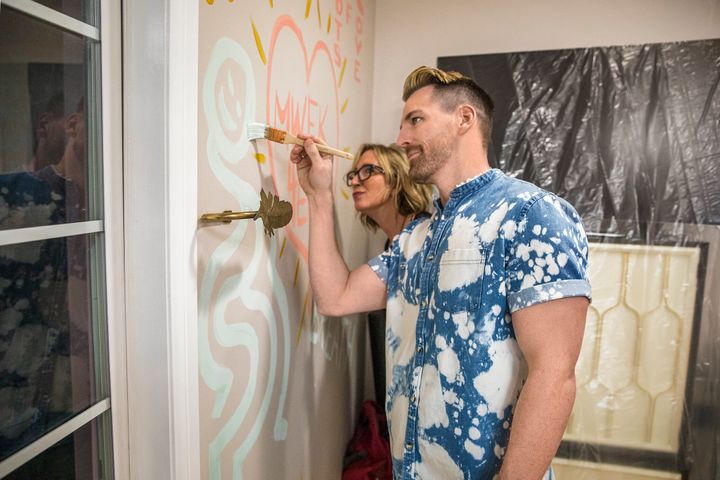
Deanna, a recently divorced mother of four, is standing in her brand new kitchen in Los Angeles. She’s beaming as she lays eyes on the “bold” chartreuse cabinets, paired expertly with clean black marble countertops, a geometric white tile backsplash and shiny new stainless steel appliances.
“Does this kitchen remind you of your ex anymore?” asks interior designer Orlando Soria. “No,” she laughs. “Not. At. All.”
This is one of the climactic scenes in “Unspouse My House,” which premiered on HGTV on June 6 and is hosted by Soria. The pitch is simple, as Soria explains at the beginning of each episode: “For years, I’ve perfected the art of creating beautiful spaces uniquely tailored to my clients. I’ve also perfected the art of getting dumped,” he says as the scene cuts to a shot of him in bed eating a giant sugary pastry. “With the help of my crew, I’ll show people going through a breakup that interior design can be a great remedy for heartbreak.”
In each 28-minute episode, viewers are introduced to a person who has recently split from a long-term, live-in partner. Soria starts by getting homeowners to spill some very mild tea about their recent split. Maybe they got divorced after 15 years of marriage. Maybe they are now raising their two-to-four children largely on their own. Maybe their ex loved an ugly brown kitchen or a tattered reclining chair or hated using coasters. Paired with each disclosure is a short animated cartoon version of said ex, being lazy in a La-Z-Boy or eating a plate of food that he clearly did not cook.
And then it’s time for the fun. Soria puts together a clean, modern design plan for a few rooms in the heartbroken’s home. The 3-D video model that viewers see is similar to what you might get on a home renovation classic like “Fixer Upper,” save for one element: The old backsplashes, tile floors, gaudy cabinets and poorly placed microwaves literally slide off the walls and are replaced by the new and bright and joyful. Then the demo team gets to work, and in a few weeks — or 15 minutes if you’re watching from the comfort of your couch — the home is reborn.
No longer haunted by ghosts of relationships past, the dwellings are meant to reflect only the tastes of the current resident, with a healthy dose of mass appeal.
If shows like “The Bachelor” provide a narratively satisfying, intentionally simplistic roadmap to finding true love, “Unspouse My House” does something similar for surviving heartbreak.
There is something fundamentally pleasing about imagining a world in which long-term partnership requires only going on a few carefully curated, high-impact dates, learning to open up about one-to-three moments of emotional trauma, and then getting engaged on a magnificently decorated platform in a far-off locale. And it is just as comforting to believe that ridding your space of the items around you — the ones that hold all of those joyful-turned-painful memories — and replacing them with shiny new ones is all it takes to rebuild your life and therefore your heart.
Of course, the idea that the interior of your home might reflect something larger about your personhood is not a new one. As early as the 19th century, there was a culture of interior decorating, particularly among middle-class women.
“Women especially were very conscious about interiors and what it said about them to friends and family,” Richard Harris, a professor at Canada’s McMaster University and author of ”Building a Market: The Rise of the Home Improvement Industry,” told HuffPost. “And there would certainly be an emotional dimension to that. If you spend so much of your time inside a dwelling, then interiors are bound to be important in an emotional sense.”
But it was not until the 1920s, Harris said, that the idea of smaller home improvement projects (and the corresponding retailers to meet the demand) really began to emerge, exploding into the mainstream culture during the post-war building boom of the 1950s.
In August 1954, an illustration of a many-armed man holding various tools and sitting on a tractor-style mower appeared on the cover of TIME Magazine, paired with the headline “Do-It-Yourself: The New Billion Dollar Hobby.” As pre-planned suburban communities began to pop up across the nation — think places like Levittown, which became shorthand for suburban whitewashed blandness — differentiating one’s home from the other identical little boxes on the hillside became something that people could both afford to do and desired to do.
Over the next four decades, households continued to shrink while homes got larger and larger, sometimes to the point of absurdity. McMansions — gaudy, often shoddily built, unnecessarily giant single-family homes, in need of filling with lots of stuff — began appearing after 1980, steadily increasing in size until the 2008 financial crisis. And in 1994, HGTV appeared like a gift from the cable gods, offering viewers a mix of programming focused exclusively on real estate and home improvement. In 2016, it became the third most-watched cable channel in the U.S.
After 1950, not only did homes get bigger and more personalized, but people began marrying later, divorcing more often and cohabitating more frequently outside of marriage. This meant that it was more and more common to experience adult life and disposable income — some of which could be spent on personalizing one’s home, something easily done with reasonably priced, mass-produced decor and a steady diet of HGTV — outside of the confines of marriage. It also meant that it became more commonplace to create a home while in a relationship that would eventually end. Thus, we arrived at a cycle of personalized interiors that necessitate updating on a regular basis to keep up with trends, to mark the passage of time and as a sign of personal expression.
It seems only natural that remaking one’s space would end up tied to the remaking of one’s heart. The message is clear: When your heart has been smashed to smithereens, healing is one new sheet set or plant or inspirational poster away.
But what does it cost to achieve home decor nirvana? In “Unspouse My House,” it takes at least $40,000. On “Fixer Upper,” the HGTV show hosted by Chip and Joanna Gaines that has spawned a home decor empire and literally renewed tourism in Waco, Texas, the all-in budgets can soar upward of $500,000. Even Marie Kondo’s custom boxes cost $89.
In a late-stage capitalist society, dramatically reorganizing your life doesn’t come cheap.
If you’re wondering what to buy to fill the void in your heart and home, just turn to Google. When you search “breakup home decor,” you’ll turn up more than 10 million results.
There are lists of “Things You Need To Have In Your New Place Post-Breakup” (a bean bag chair, flannel sheets, inspirational wall art), “Ways To Redecorate Your Space Stat” (get rid of things, repaint, get new bedding), “Little Things You Can Do To Reclaim Your Space” (sage your home, discard your sheets, clean like a maniac) and “Basics To Get Your Home And Sanity Back” (add new art, treat yourself to fresh flowers, be grateful for your home).
A stylist can guide you back to feeling at home via three little tips and eight conveniently linked-to items you can purchase on Society6. There are Etsy pages filled with post-breakup boxes and candles and posters and mugs. And, of course, there are plants (fiddle leaf fig trees, cacti).
I have personally experienced the allure of home retail therapy. A week before I last moved, I got dumped.
Surveys have shown that along with a breakup or divorce, moving is the life event people are most likely to rank as extremely stressful. I got a lovely one-two punch. Within the course of seven days I changed my neighborhood, my apartment and my relationship status, and I was left to reconfigure my home and my emotional health. So I threw myself into home decorating with a vengeance.
I filled my apartment with plants. It’s always good to have at least one other living thing in your space. I placed crystals in the four corners after my friend gave them to me as a housewarming present, meant to cleanse the space and bring positive energy. (A little too “woo woo” for me, but desperate times.) I got an aggressively pink, velvet couch and a shiny gold light fixture. I wallpapered an accent wall in my bedroom, and ordered a bunch of random, affordable art. I had a crisp tile backsplash added to my kitchen.
Every day that I added something to the apartment felt like a small triumph.
“But what does it cost to achieve home decor nirvana?”
I also began to watch home decor shows, tearing through Netflix’s “Tidying Up With Marie Kondo” and every season of HGTV’s “Fixer Upper.” These shows acted like a salve, soothing the bits of me that still felt raw, lulling me into calm with their predictable mundanity.
In each iteration of these home improvement shows, a family or a couple has a space that is imperfect, but has potential. Fifty minutes later, with new tiling and a re-routed electrical line and some shiplap and a farmhouse sink — or in the case of “Tidying Up,” organized closets and new boxes and a new method of folding — their home is transformed. And not just their home, but their lives. The beautified and organized offices offer the promise of renewed creativity. The soaking tubs and tiled bathroom walls signal the opportunity to cleanse and recharge.
In a traditional home improvement show, this emotional journey is implied, but on “Unspouse My House,” it’s made explicit. “This is a new chapter,” says divorced mother Killie during the end of episode three. “And we can make this new chapter whatever we want it to be.”
“A dramatic reorganization of the home causes correspondingly dramatic changes in lifestyle and perspective,” Kondo wrote in her bestselling book, ”The Life-Changing Magic of Tidying Up.” “It is life transforming.”
But what does it mean when our drive to transform our lives is irrevocably tied to a cycle of accruing things, putting them on display and then ridding ourselves of them? If self-fulfillment and healing require substantial financial investment, it follows that many will find these things out of reach.
I am the first to admit that filling my new apartment with things that reflected me, things that, to borrow a Kondo-ism, “sparked joy,” absolutely helped me begin to feel whole again. It gave me a project, something to fixate on, something to accomplish.
But a fundamental friction exists: The more we explicitly view the purchasing of material goods as a known path to emotional salvation, the more effective that behavior will feel. Just as self-care has been co-opted by capitalism, so too has post-breakup healing.
How seductive and a little bit true and invariably corrupted, to believe that the correct wallpaper and the happiest neon plant and the comfiest coziest couch might just allow you to be correct and happy and cozy in your own life.
As Soria says at the end of the introduction to each new episode of “Unspouse My House”: “It’s time to start over.” The no-longer-beige kitchen of your dreams is implied.
